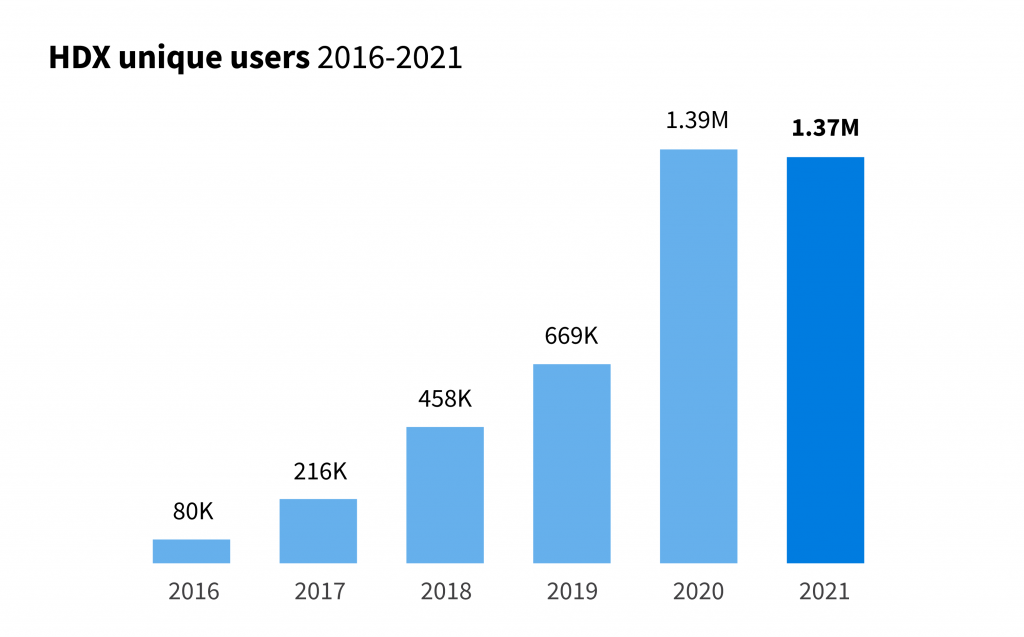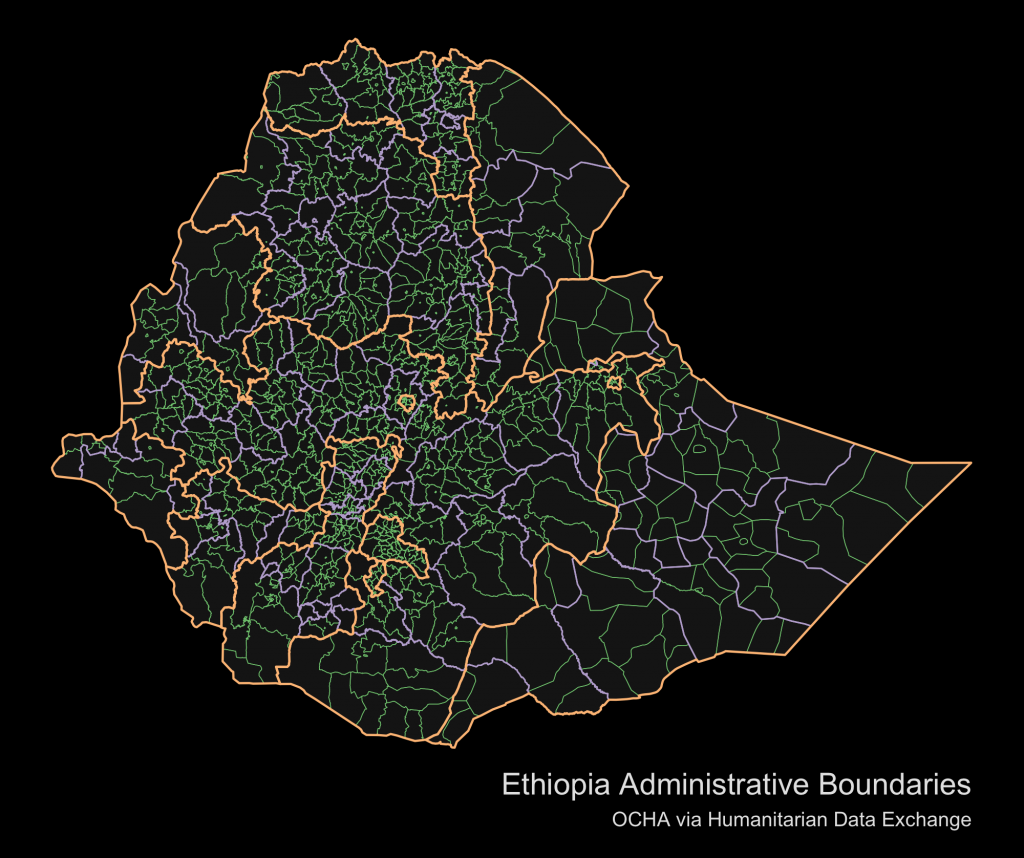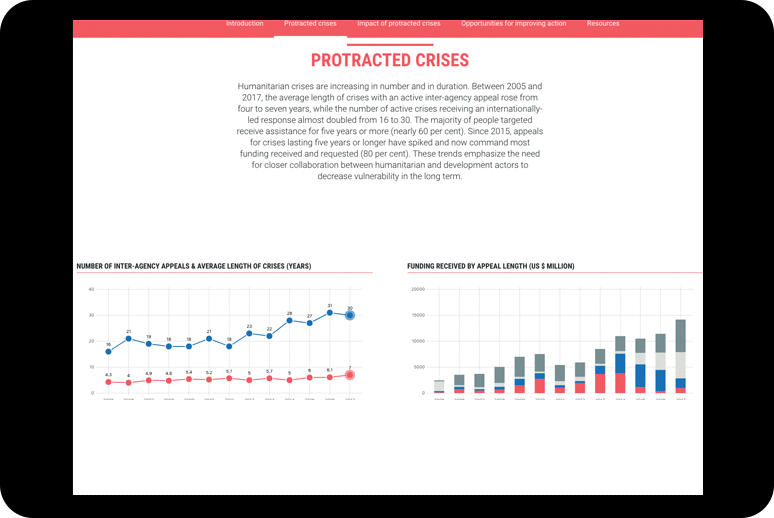Share
In 2021, the Humanitarian Data Exchange (HDX) was used by 1.4 million people in 236 countries and territories around the world, maintaining the record growth we saw in 2020 due to the onset of the COVID-19 pandemic. Organizations added 2,071 new datasets to the platform, bringing the total to almost 18,500 datasets, which were downloaded over 1.8 million times. Below I provide a closer look at the trends from this year and highlight several of the new organizations that joined our community.

Although HDX includes data about all countries in the world, we continue to have a specific focus on the data and organizations working in 27 countries with Humanitarian Response Plans (HRP). In 2021, 35% of all datasets downloaded were related to an HRP location. The most popular crises included Nigeria, Ethiopia, DRC, Burkina Faso and Colombia.
Each of the 27 HRP location pages on HDX includes a Data Grid to track the priority operational data that is available or missing, something that we will provide more analysis on in the next edition of the State of Open Humanitarian Data, which will be released at the end of January 2022. In brief, we can say that we have made good progress in closing data gaps across priority humanitarian operations, with Afghanistan having the most complete Data Grid. Visit the Overview of Data Grids page on HDX for more details on data completeness across crises and categories.
One of the most popular types of data on HDX this year and every year is geospatial data. This includes the Common Operational Datasets (CODs) which are the standard subnational administrative divisions and baseline population data for each country. The popularity of CODs is also a good indicator of the utility of HDX in the field. While CODs account for fewer than 3% of all datasets on HDX, they account for 7% of the total dataset downloads globally and 32% of the total downloads from HRP locations.

The COVID-19 pandemic continued to generate demand for data about cases and deaths in countries around the world. The most popular dataset on HDX in 2021 was the Novel Coronavirus (COVID-19) Cases from Johns Hopkins University Center for Systems Science and Engineering. It was downloaded 73,000 times (down from 334,000 downloads in 2020). Another popular dataset, downloaded 19,000 times, was the COVID-19 Tests Performed by Country from Our World in Data.
The pandemic also brought new organizations to HDX, such as Global.health which provided access to datasets with real-time epidemiological anonymized line-list data in five countries. The HDX COVID-19 Data Explorer continued to be a popular destination for the latest insights on how COVID-19 is impacting countries with humanitarian operations: over 120,000 people visited the dashboard in 2021, with top user locations including the US, the Philippines, the UK and Bangladesh.
Overall, we welcomed twenty new organizations to HDX in 2021. Together, they have already shared 190 new datasets. A few highlights include:
- Global Earthquake Model Foundation shared data related to earthquake risk assessments for 47 countries. The data is based on earth observation and includes estimates for the number of buildings, building areas, and the rebuilding value for each country. The data is intended for modeling and loss estimation should an earthquake occur.
- Inter-Agency Coordination Platform for Refugees and Migrants from Venezuela shared data related to the regional response plans for 2021 and 2022. The datasets include the number of people in need, baseline population with breakdowns by age and gender, and the number of partner implementing organizations for each planned activity.
- Iraq Shelter Cluster shared a dataset containing assessment and rehabilitation of war-damaged shelter for returnees across the country. The data includes the location of damaged buildings at the village, subdistrict, district and governorate level; reporting is provided by both shelter cluster partners and development/durable solution actors in Iraq.
- The Standby Partnership Network shared a dataset that includes information about the number of deployments, countries of deployment and duty stations from 2018-2021.
We look forward to working with new and existing organizations in 2022 and beyond. The data on HDX helps humanitarians and partners to understand and respond to crises around the world. And of course a big thank you to steadfast partners such as WFP, UNHCR, IOM and HOTOSM who continue to maintain and share their data year after year.
We have just hired a new HDX Community Manager, Tony Burke, who will be focusing on supporting data contributors and making sure users are getting the most out of the data on the platform. Read the blog from Kasia Chmielinski on The Role of Trust in Managing a Growing Data Platform for insights on data contributors and ideas for a premier status programme for active organizations.
Lastly, join our next HDX Dataset Deep Dive with Data for Good at Meta to learn more about their Relative Wealth Index. Register here and visit the Centre’s YouTube channel to catch up on previous webinars.

